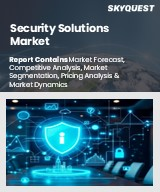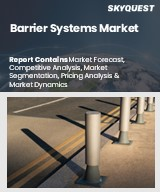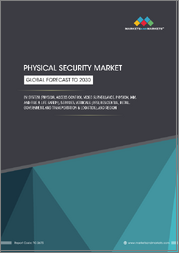
|
시장보고서
상품코드
1574105
세계의 접근 제어 시장 - 예측(2024-2029년)Access Control Market - Forecasts from 2024 to 2029 |
||||||
접근 제어 시장은 2024년 88억 2,800만 달러로 평가되었고, 연평균 8.13% 성장하여 2029년에는 130억 5,200만 달러에 달할 것으로 예상됩니다.
접근 제어는 시스템, 환경, 건물에 누가 또는 무엇이 침입할 수 있는지를 규제하는 보안 시스템입니다. 시스템, 물리적 또는 가상 자원에 대한 침입을 제한합니다. 컴퓨팅에서 접근 제어는 사용자가 시스템, 리소스, 데이터 및 특정 권한에 대한 액세스를 허용하거나 거부하는 방법입니다. 이러한 제어 시스템은 암호, 개인 식별 번호, 생체 인식 스캔, 보안 토큰 등을 포함한 로그인 인증 정보를 평가하여 사용자 식별 인증 및 승인을 수행합니다. 주요 목적은 허가된 인원만 시스템이나 건물에 출입할 수 있도록 허용하는 것입니다.
공공 및 민간 부문의 보안에 대한 관심이 높아지면서 첨단 기술에 대한 높은 채택률을 보이고 있습니다. 24시간 보호되는 자동화된 시스템과 주거 및 상업 공간 모두에 대한 접근성이 수요의 원동력이 되고 있습니다. 또한, SaaS(Software as a Service)와 온프레미스 디바이스의 장점과 ACaaS(Access Control as a Service)가 결합된 ACaaS(Access Control as a Service)의 장점도 있습니다. 이러한 솔루션은 원격으로 안전한 데이터 저장 및 데이터 백업 기능을 제공하기 때문에 점점 더 인기를 얻고 있으며, ACaaS 솔루션에 대한 수요가 증가하는 이유는 과거 액세스 기록을 영구적으로 저장할 수 있기 때문입니다. 클라우드 컴퓨팅과 무선 액세스 포인트의 보안 산업 진출은 급속한 변화와 함께 접근 제어 시스템에 대한 수요를 촉진할 것으로 예상됩니다. 스마트 빌딩, 스마트 홈, 스마트 인프라 개념 증가로 인해 물리적 보안에 대한 수요도 증가할 것입니다. 클라우드 컴퓨팅 플랫폼의 사용 증가, 무선 보안 시스템의 보급, 범죄율 증가는 첨단 기술에 대한 새로운 기회를 창출하고 있습니다.
접근제어 시장 성장 촉진요인:
- 보안 우려와 규제 준수
전 세계가 상호 연결됨에 따라 보안 문제에 대한 진지한 접근이 요구되고 있습니다. 사이버 공격, 데이터 유출, 물리적 보안 위험이 만연함에 따라 기업들은 출입통제 시스템에 대한 투자를 늘리고 있습니다. 출입 통제는 사람들의 안전과 소지품을 보호하든, 기밀 정보를 보호하든, 모든 종합적인 보안 체계의 핵심적인 부분입니다. 또한, 정부, 금융, 의료 등 다양한 분야의 접근 제어는 산업별 규제 및 감독 기관에 의해 엄격한 규정이 적용되고 있습니다. 예를 들어, GDPR(EU 개인정보보호규정)(EU 개인정보보호규정), PCI DSS, HIPAA는 해당 규정을 준수하기 위해 적절한 접근 제어 정책을 도입할 것을 요구하고 있습니다. 이에 따라 접근 제어 시장 규모는 이러한 요구에 부응하는 형태로 확대되고 있습니다.
접근 제어 시장의 지리적 전망
- 아태지역은 예측 기간 동안 급성장할 것으로 예상됨
아태지역은 경제 발전에 따라 출입통제 시스템에 대한 수요가 빠르게 증가하고 있으며, 민관 모두 보안 대책 강화에 대한 요구가 높아지고 있습니다. 스마트시티의 발전, 도시화, 인프라 구축은 출입통제 시스템의 세계 보급을 촉진하는 주요 요인이며, 아시아태평양의 제조업은 공장 보안 대책으로 출입통제 시스템을 적극적으로 채택하고 있습니다.
이 보고서를 구입해야 하는 이유
- 통찰력 있는 분석 : 고객 부문, 정부 정책 및 사회경제적 요인, 소비자 선호도, 산업 분야 및 기타 하위 부문에 초점을 맞추어 주요 지역과 신흥 지역을 포괄하는 상세한 시장 인사이트을 얻을 수 있습니다.
- 경쟁 환경: 세계 주요 기업들이 채택하고 있는 전략적 전략을 이해하고, 적절한 전략을 통한 시장 침투 가능성을 파악합니다.
- 시장 성장 촉진요인과 향후 동향 : 역동적인 요인과 매우 중요한 시장 동향, 그리고 이들이 향후 시장 발전을 어떻게 형성할 것인지에 대해 알아봅니다.
- 실행 가능한 제안: 역동적인 환경 속에서 새로운 비즈니스 스트림과 수익을 창출하기 위한 전략적 의사결정을 내릴 수 있도록 통찰력을 활용합니다.
- 광범위한 독자층: 스타트업, 연구기관, 컨설턴트, 중소기업, 대기업에 유익하고 비용 효율적임.
기업은 어떤 목적으로 우리의 보고서를 사용하나요?
산업 및 시장 인사이트, 사업 기회 평가, 제품 수요 예측, 시장 진출 전략, 지리적 확장, 설비 투자 결정, 규제 프레임워크 및 영향, 신제품 개발, 경쟁의 영향
조사 범위
- 2022년부터 2029년까지의 과거 데이터 및 전망
- 성장 기회, 과제, 공급망 전망, 규제 프레임워크, 고객 행동, 트렌드 분석
- 경쟁사 시장 상황, 전략 및 시장 점유율 분석
- 각 국가를 포함한 부문 및 지역별 수익 성장 및 예측 평가
- 기업 프로파일(전략, 제품, 재무 정보, 주요 발전 등)
접근 제어 시장은 다음과 같이 세분화되어 분석됩니다:
제품별
- 하드웨어
- 생체인식
- 카드 리더기
- 휴대폰
- 기타
- 소프트웨어
서비스별
- 설치 및 통합
- 지원 및 유지보수
- 전문 서비스
전개별
- 클라우드
- 온프레미스
최종사용자별
- 통신
- 은행/금융서비스/보험(BFSI)
- 정부
- 건강관리
- 기타
지역별
- 북미
- 미국
- 캐나다
- 멕시코
- 남미
- 브라질
- 아르헨티나
- 기타
- 유럽
- 독일
- 프랑스
- 스페인
- 영국
- 기타
- 중동 및 아프리카
- 아랍에미리트(UAE)
- 사우디아라비아
- 기타
- 아시아태평양
- 중국
- 일본
- 인도
- 한국
- 태국
- 인도네시아
- 대만
- 기타
목차
제1장 서론
- 시장 개요
- 시장의 정의
- 조사 범위
- 시장 세분화
- 통화
- 전제조건
- 기준년과 예측년 타임라인
- 이해관계자에 있어서의 주요 이점
제2장 조사 방법
- 조사 디자인
- 조사 과정
제3장 주요 요약
- 주요 조사 결과
제4장 시장 역학
- 시장 성장 촉진요인
- 시장 성장 억제요인
- Porter의 Five Forces 분석
- 업계 밸류체인 분석
- 애널리스트의 견해
제5장 액세스·컨트롤 시장 : 제품별
- 서론
- 하드웨어
- 생체인식
- 카드 및 리더
- 휴대폰
- 기타
- 소프트웨어
제6장 액세스·컨트롤 시장 : 서비스별
- 서론
- 설치 및 통합
- 지원 및 유지관리
- 전문 서비스
제7장 액세스·컨트롤 시장 : 전개 형태별
- 서론
- 클라우드
- 온프레미스
제8장 액세스·컨트롤 시장 : 최종사용자별
- 서론
- 통신
- 은행/금융서비스/보험(BFSI)
- 정부
- 헬스케어
- 기타
제9장 액세스·컨트롤 시장 : 지역별
- 서론
- 북미
- 제품별
- 서비스별
- 전개 형태별
- 최종사용자별
- 국가별
- 남미
- 제품별
- 서비스별
- 전개 형태별
- 최종사용자별
- 국가별
- 유럽
- 제품별
- 서비스별
- 전개 형태별
- 최종사용자별
- 국가별
- 중동 및 아프리카
- 제품별
- 서비스별
- 전개 형태별
- 최종사용자별
- 국가별
- 아시아태평양
- 제품별
- 서비스별
- 전개 형태별
- 최종사용자별
- 국가별
제10장 경쟁 환경과 분석
- 주요 기업과 전략 분석
- 시장 점유율 분석
- 합병, 인수, 합의 및 협업
- 경쟁 대시보드
제11장 기업 개요
- Vanderbilt Industries
- Gemalto NV
- Honeywell International Inc
- IDEMIA
- Matrix Comsec Pvt. Ltd.
- Brady Corporation
- Tyco International
- Protection One, a division of ADT LLC
- NEC Corporation
- Siemens
- Hangzhou Hikvision Digital Technology Co., Ltd.
- HID Global Corporation, an ASSA ABLOY Group
The access control market is evaluated at US$8.828 billion in 2024, growing at a CAGR of 8.13%, reaching a market size of US$13.052 billion by 2029.
Access control is a security system that regulates who or what can enter a system, an environment, or a building. It restricts entry to the system or physical or virtual resources. In computing, access control is how users can be granted or refused access to systems, resources, data, and particular rights. These control systems perform identification authentication and authorization of users by evaluating login credentials that include passwords, personal identification numbers, biometric scans, security tokens, and others. The key purpose is to grant entrance to a system or building only to authorized personnel.
The public and private sectors' growing concerns about security have led to a high adoption rate of cutting-edge technology. Demand is being driven by the automated systems' round-the-clock protection and accessibility in both residential and commercial spaces. Additionally, software as a service (SaaS) and on-premises device benefits are combined with access control as a service (ACaaS). These solutions are becoming more and more popular because they offer remote, secure data storage as well as data backup capabilities. The increasing demand for the ACaaS solution is due to its ability to keep permanent records of previous accesses. The entry of cloud computing and wireless access points into the security industry, along with its rapid transformation, is expected to drive demand for access control systems. The need for physical security will also be fueled by the growing number of smart buildings, smart homes, and smart infrastructure initiatives. New opportunities for advanced technologies are being created by the increasing use of cloud computing platforms, the growing prevalence of wireless security systems, and rising crime rates.
Access Control Market Drivers:
- Security concerns and regulatory compliance
The interconnectedness of our world has demanded serious attention to security issues. Organizations are investing more in access control systems because cyber attacks, data breaches, and physical security risks have become rampant. Be it for safeguarding people's safety and physical belongings or guarding sensitive information, access control is a major section of any all-encompassing security scheme. More so, there are rigorous stipulations for access management in various sectors, including government, finance, and healthcare, which are put forward by industry-specific regulations and regulatory bodies. For instance, GDPR, PCI DSS, and HIPAA command that good access management policies be in place to comply with its provisions. Consequently, there is an increase in the scope of the market for access control in response to this requirement.
Access Control Market Geographical Outlook
- Asia Pacific is witnessing exponential growth during the forecast period
There has been a rapid growth in demand for access control systems throughout the Asia Pacific region due to economic development, which has led to demand for enhanced security measures in both the public and private sectors. Smart city development, together with urbanization as well as infrastructure growth, are key factors driving the use of access control systems globally, while Asia Pacific's manufacturing industry adopts them heavily to secure their factories.
Reasons for buying this report:-
- Insightful Analysis: Gain detailed market insights covering major as well as emerging geographical regions, focusing on customer segments, government policies and socio-economic factors, consumer preferences, industry verticals, other sub- segments.
- Competitive Landscape: Understand the strategic maneuvers employed by key players globally to understand possible market penetration with the correct strategy.
- Market Drivers & Future Trends: Explore the dynamic factors and pivotal market trends and how they will shape up future market developments.
- Actionable Recommendations: Utilize the insights to exercise strategic decision to uncover new business streams and revenues in a dynamic environment.
- Caters to a Wide Audience: Beneficial and cost-effective for startups, research institutions, consultants, SMEs, and large enterprises.
What do businesses use our reports for?
Industry and Market Insights, Opportunity Assessment, Product Demand Forecasting, Market Entry Strategy, Geographical Expansion, Capital Investment Decisions, Regulatory Framework & Implications, New Product Development, Competitive Intelligence
Report Coverage:
- Historical data & forecasts from 2022 to 2029
- Growth Opportunities, Challenges, Supply Chain Outlook, Regulatory Framework, Customer Behaviour, and Trend Analysis
- Competitive Positioning, Strategies, and Market Share Analysis
- Revenue Growth and Forecast Assessment of segments and regions including countries
- Company Profiling (Strategies, Products, Financial Information, and Key Developments among others)
The Access Control market is segmented and analyzed as follows:
By Product
- Hardware
- Biometrics
- Cards and Readers
- Mobile Phones
- Others
- Software
By Service
- Installation and Integration
- Support and Maintenance
- Professional Services
By Deployment
- Cloud
- On-premise
By End User Industry
- Telecommunication
- BFSI
- Government
- Healthcare
- Others
By Geography
- North America
- United States
- Canada
- Mexico
- South America
- Brazil
- Argentina
- Others
- Europe
- Germany
- France
- Spain
- United Kingdom
- Others
- Middle East and Africa
- UAE
- Saudi Arabia
- Others
- Asia Pacific
- China
- Japan
- India
- South Korea
- Thailand
- Indonesia
- Taiwan
- Others
TABLE OF CONTENTS
1. INTRODUCTION
- 1.1. Market Overview
- 1.2. Market Definition
- 1.3. Scope of the Study
- 1.4. Market Segmentation
- 1.5. Currency
- 1.6. Assumptions
- 1.7. Base and Forecast Years Timeline
- 1.8. Key Benefits to the Stakeholder
2. RESEARCH METHODOLOGY
- 2.1. Research Design
- 2.2. Research Processes
3. EXECUTIVE SUMMARY
- 3.1. Key Findings
4. MARKET DYNAMICS
- 4.1. Market Drivers
- 4.2. Market Restraints
- 4.3. Porter's Five Forces Analysis
- 4.3.1. Bargaining Power of Suppliers
- 4.3.2. Bargaining Power of Buyers
- 4.3.3. Threat of New Entrants
- 4.3.4. Threat of Substitutes
- 4.3.5. Competitive Rivalry in the Industry
- 4.4. Industry Value Chain Analysis
- 4.5. Analyst View
5. ACCESS CONTROL MARKET BY PRODUCT
- 5.1. Introduction
- 5.2. Hardware
- 5.2.1. Biometrics
- 5.2.2. Cards and Readers
- 5.2.3. Mobile Phones
- 5.2.4. Others
- 5.3. Software
6. ACCESS CONTROL MARKET BY SERVICE
- 6.1. Introduction
- 6.2. Installation and Integration
- 6.3. Support and Maintenance
- 6.4. Professional Services
7. ACCESS CONTROL MARKET BY DEPLOYMENT
- 7.1. Introduction
- 7.2. Cloud
- 7.3. On-premise
8. ACCESS CONTROL MARKET BY END-USER INDUSTRY
- 8.1. Introduction
- 8.2. Telecommunication
- 8.3. BFSI
- 8.4. Government
- 8.5. Healthcare
- 8.6. Others
9. ACCESS CONTROL MARKET BY GEOGRAPHY
- 9.1. Introduction
- 9.2. North America
- 9.2.1. By Product
- 9.2.2. By Service
- 9.2.3. By Deployment
- 9.2.4. By End-User Industry
- 9.2.5. By Country
- 9.2.5.1. United States
- 9.2.5.2. Canada
- 9.2.5.3. Mexico
- 9.3. South America
- 9.3.1. By Product
- 9.3.2. By Service
- 9.3.3. By Deployment
- 9.3.4. By End-User Industry
- 9.3.5. By Country
- 9.3.5.1. Brazil
- 9.3.5.2. Argentina
- 9.3.5.3. Others
- 9.4. Europe
- 9.4.1. By Product
- 9.4.2. By Service
- 9.4.3. By Deployment
- 9.4.4. By End-User Industry
- 9.4.5. By Country
- 9.4.5.1. Germany
- 9.4.5.2. France
- 9.4.5.3. Spain
- 9.4.5.4. United Kingdom
- 9.4.5.5. Others
- 9.5. Middle East and Africa
- 9.5.1. By Product
- 9.5.2. By Service
- 9.5.3. By Deployment
- 9.5.4. By End-User Industry
- 9.5.5. By Country
- 9.5.5.1. UAE
- 9.5.5.2. Saudi Arabia
- 9.5.5.3. Others
- 9.6. Asia Pacific
- 9.6.1. By Product
- 9.6.2. By Service
- 9.6.3. By Deployment
- 9.6.4. By End-User Industry
- 9.6.5. By Country
- 9.6.5.1. China
- 9.6.5.2. Japan
- 9.6.5.3. India
- 9.6.5.4. South Korea
- 9.6.5.5. Thailand
- 9.6.5.6. Indonesia
- 9.6.5.7. Taiwan
- 9.6.5.8. Others
10. COMPETITIVE ENVIRONMENT AND ANALYSIS
- 10.1. Major Players and Strategy Analysis
- 10.2. Market Share Analysis
- 10.3. Mergers, Acquisitions, Agreements, and Collaborations
- 10.4. Competitive Dashboard
11. COMPANY PROFILES
- 11.1. Vanderbilt Industries
- 11.2. Gemalto NV
- 11.3. Honeywell International Inc
- 11.4. IDEMIA
- 11.5. Matrix Comsec Pvt. Ltd.
- 11.6. Brady Corporation
- 11.7. Tyco International
- 11.8. Protection One, a division of ADT LLC
- 11.9. NEC Corporation
- 11.10. Siemens
- 11.11. Hangzhou Hikvision Digital Technology Co., Ltd.
- 11.12. HID Global Corporation, an ASSA ABLOY Group



















